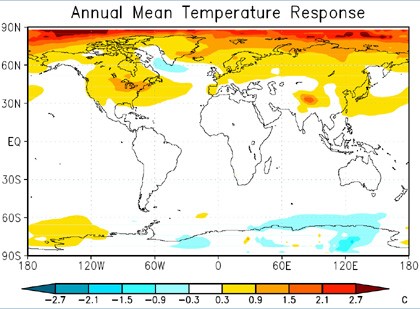1) La neige sale est un contributeur important
au réchauffement de l'Arctique
ADIT: http://www.bulletins-electroniques.com/actualites/43323.htm
Une équipe de chercheurs de l'université
de Californie à Irvine, menée par Charles Zender, s'est intéressée
à la part que prenait les dépôts de "carbone
noir" (suies, résidus de la combustion incomplète
de carburant tel que le pétrole, le gaz naturel ou le bois) dans
le réchauffement climatique de l'Arctique. En effet le "carbone
noir", en se déposant sur la neige, en diminue le pouvoir réflectif,
et en augmente donc la température. Ceci a notamment pour effet
d'accélérer la fonte de ces neiges, ce qui réchauffe
davantage le climat local (en diminuant l'albédo terrestre).
En couplant un modèle qu'ils ont élaboré,
le Snow, Ice and Aerosol Radiative (SNICAR, modèle permettant de
décrire l'évolution de la neige au cours du temps, notamment
sa perte de pouvoir réflectif), avec un modèle de circulation
des particules de carbone, les chercheurs ont pu mesurer d'une part la
contribution du " carbone noir " et de ses effets sur la neige au forçage
climatique et d'autre part la participation des émissions d'origine
anthropique à ce type de forçage pour les années 1998
et 2001.
D'après leur modèle, le "carbone
noir" et les mécanismes de rétroaction climatique associés
ont augmenté la température moyenne mondiale à la
surface du globe de 0.15°C en 1998 et de 0.10°C en 2001 (Dans son
4ème rapport d'évaluation, l'IPCC évalue l'augmentation
de la température de surface mondiale au cours des 100 dernières
années à 0.8°C). Les températures de l'Arctique,
quant à elles, se sont élevées de 1.61°C en 1998
et 0.50°C en 2001. Des feux de forêts importants dans les régions
boréales en 1998 sont sans doute à l'origine des disparités
entre les deux années. Sur ces deux années les émissions
d'origine anthropique sont à l'origine d'au moins 80% du forçage
climatique associé au "carbone noir". Limiter les émissions
industrielles de suie permettrait de diminuer rapidement le forçage
climatique associé au "carbone noir".
Contact:
M. G. Flanner et al., Present-day climate forcing and response from
black carbon in snow, Journal of Geophysical Research, 2007, 112(11):
http://dust.ess.uci.edu/ppr/ppr_FZR07.pdf
(17 pages )
2) Dirty snow may warm Arctic
as much as greenhouse gases
The global warming debate has focused on carbon dioxide
emissions, but scientists at UC Irvine have determined that a lesser-known
mechanism – dirty snow – can explain one-third or more of the Arctic warming
primarily attributed to greenhouse gases.
Snow becomes dirty when soot from tailpipes,
smoke stacks and forest fires enters the atmosphere and falls to the ground.
Soot-infused snow is darker than natural snow. Dark surfaces absorb sunlight
and cause warming, while bright surfaces reflect heat back into space and
cause cooling.
"When we inject dirty particles into the
atmosphere and they fall onto snow, the net effect is we warm the polar
latitudes," said Charlie Zender, associate professor of Earth system
science at UCI and co-author of the study. "Dark soot can heat up quickly.
It's like placing tiny toaster ovens into the snow pack." |
The study appears this week in the Journal of Geophysical
Research.
Dirty snow has had a significant impact on
climate warming since the Industrial Revolution. In the past 200 years,
the Earth has warmed about .8 degree Celsius. Zender, graduate student
Mark Flanner, and their colleagues calculated that dirty snow caused the
Earth's temperature to rise .1 to .15 degree, or up to 19% of the total
warming.
In the past two centuries, the Arctic has
warmed about 1.6 degrees. Dirty snow caused .5 to 1.5 degrees of warming,
or up to 94% of the observed change, the scientists determined.
The amount of warming by dirty snow varied
from year to year, with higher temperatures in years with many forest fires.
Greenhouse gases, which trap outgoing energy, are primarily responsible
for the remaining temperature increase and are considered the Earth's most
important overall climate changing mechanism. Other human influences on
Arctic climate change are particles in the atmosphere, including soot;
clouds; and land use.
Humans create the majority of airborne soot
through industry and fuel combustion, while forest and open-field fires
account for the rest. Because of human activity, greenhouse gas levels
have increased by one-third in the last two centuries.
"A one-third change in concentration is
huge, yet the Earth has only warmed about .8 degrees because the effect
is distributed globally," Zender said. "A small amount of snow impurities
in the Arctic have caused a significant temperature response there."
Previous studies have analyzed dirty snow's
effect on climate, but this is the first to take into account realistic
emissions from forest fires in the Northern Hemisphere and how warming
affects the thickness of the snow pack.
In some polar areas, impurities in the snow
have caused enough melting to expose underlying sea ice or soil that is
significantly darker than the snow. The darker surfaces absorb sunlight
more rapidly than snow, causing additional warming. This cycle causes temperatures
in the polar regions to rise as much as 3 degrees Celsius during some seasons,
the scientists say.
"Once the snow is gone, the soot that caused
the snow to melt continues to have an effect because the ground surface
is darker and retains more heat," Zender said.
Dirty snow is prevalent in East Asia, Northern
Europe and Northeastern United States.
Zender believes policymakers could use these
research results to develop regulations to mitigate global warming. Limiting
industrial soot emissions and switching to cleaner-burning fuels would
leave snow brighter, he says. New snow falls each year, and if it contained
fewer impurities, the ground would brighten and temperatures would cool.
Carbon dioxide lives in the atmosphere for a century, so cutting back on
emissions can prevent further warming but does not produce immediate cooling.
UCI scientist James Randerson and Philip Rasch,
a scientist at the National Center for Atmospheric Research in Boulder,
Colo., also worked on the study. The National Science Foundation and NASA
funded this research. |
